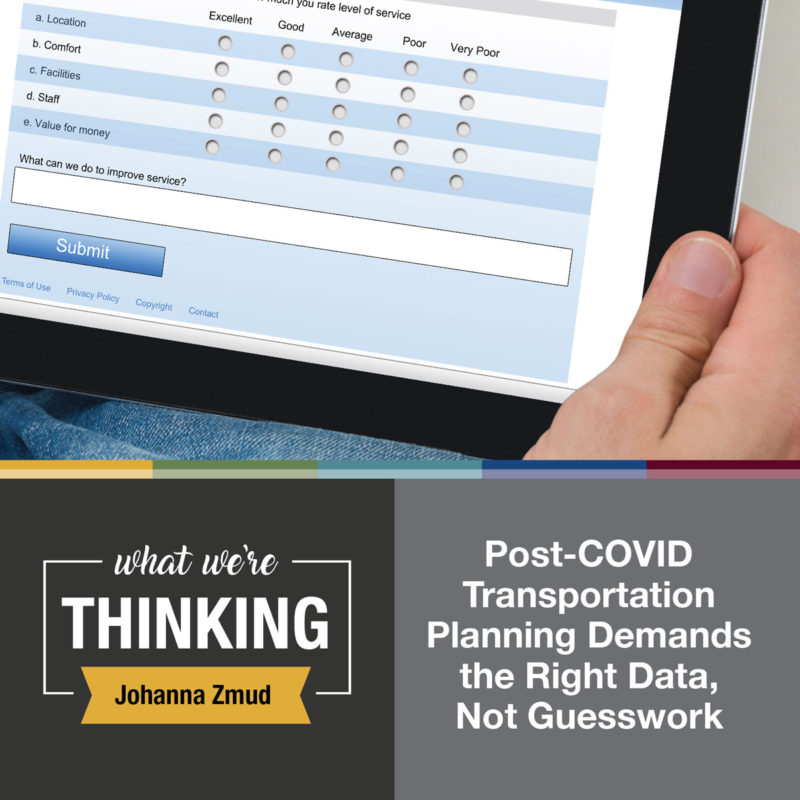 By Johanna Zmud
By Johanna Zmud
When will people start vacationing? How many will stick with work-from-home routines? Will online grocery shopping be a fading fad or an enduring trend?
The answers to these and other related questions have big implications not only for how Americans live and work after the current crisis, but also for how they get around post-pandemic. Consequently, the public agencies responsible for transportation planning and policy need evidence-based insights, giving wisdom to the tug of war between what we want to happen versus what will actually happen. Decision makers are not yet gathering that information, but they should be.
So far, much of what we know comes from cell phones and the apps that track when and where people move every day. At the moment, apart from infection case data, smartphone location info is about the only information available. That’s not to say that it doesn’t have value. It tells us where people are going as restrictions are relaxed. Epidemiologists also use that information to illustrate a slowing of virus transmission following a lockdown, or forecast a spike in cases under other circumstances.
But, cell phone data can’t tell a story about what people did while they were out – whether they kept their distance from others, or wore a mask; whether they were shopping with a purpose or just out to relieve their cabin fever symptoms. Answers to those types of questions would provide real insight into which travel behaviors will stick post-COVID and which will not. Many are hoping the reduced carbon-intensive, more active transportation behaviors stick. Whether that happens depends on people’s motivations behind their transportation decisions.
Pings from cell towers can’t reveal the impetus behind choices that people make about using (or shunning) public transportation or ride-hailing services, nor can they give us insight on other important questions:
How extensively are people substituting communications technologies for trips – before, during, and after the lockdown?
How does pent-up travel demand alter substitution behavior? Will that shopping-via-smartphone habit endure, or will it be eclipsed by a simple desire to select our own goods (socially-distanced or not)?
Will that same craving to be out and about boost car sales for first-time buyers? How many might also be motivated to drive because of waning trust in public transit? For those able to buy but still on the fence, will historic sales incentives be enough to seal the deal?
To get such answers, public agencies need to reach out to people. If they don’t get to the why beyond the what, they’re doing little more than projecting a rationale on top of people’s observed movements. That does little good toward shaping the best path forward, and may lead to at best ineffective, and at worst, harmful planning and policy decisions.
Surveys can produce part of what decision makers need, but they’ll also need to actually talk to people through interviews and focus groups. They should be gathering that information both now and later. People may answer one way in the moment, and differently a month or six months later when they’re less driven by emotion. Certainly, such data collection costs money, but the knowledge produced is priceless.
So, what can decision makers do with this knowledge?
They’ll know better which COVID-induced travel behaviors are likely to stick.
They’ll know what that could mean for things like street and highway use and the viability of active travel modes like bike-share and walking.
They’ll know better what to expect with traffic congestion, air quality, and emissions reduction.
They’ll know more about how to schedule and provide transit service, with an eye toward higher standards for rider safety and security.
They’ll know more to guide land use planning for office and retail locations.
By understanding the motivation behind people’s actions, public agencies can do a far better job of planning for a post-pandemic transportation system – one that serves America’s needs broadly, reliably, and affordably.
Wanting to know how life will be on the other side of this crisis is understandable. Humans – most of us, anyway – aren’t fond of the unknown. We’re neuro-biologically hardwired to react uncomfortably to uncertainty.
But we can’t afford to let an eagerness for any answers push us into guesswork that risks yielding incomplete or wrong answers, any more than we can let a desire for a cure push us toward the wrong vaccine. In each case, being too hasty would risk doing more harm than good.
In other words, decision makers need to do less speculating and more studying.
Johanna Zmud is a senior research scientist with the Texas A&M Transportation Institute
This article was originally published in Eno Center for Transportation, June 5, 2020.